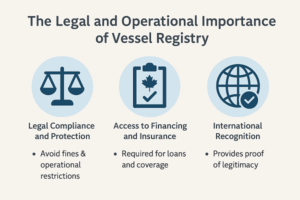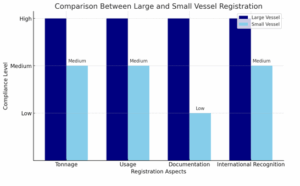Firstly, for ship owners is the compliance with maritime laws which start off with documentation that is accurate. Among the most indispensable requirements is the submission of Large Vessel Registry Forms. These forms mark the beginning of vessel registration in Canada through which the ownership, the nationality, and the operational legality of the ship are clearly outlined. In the absence of such documents, vessel owners will be in danger of the occurrence of unnecessary problems in their works such as they will cause them to wait for a long time or to pay fines and even being banned from running in the Canadian and international waters.
This article tells you what Large Vessel Registry Forms are; their goal; and why these forms matter most. Next, you read what these forms include, what they are like compared with other registry options, and what the steps are for a smooth completion. The result is that you will be well-versed with Transport Canada regulations and hence be capable to effectively carry out vessel documentation.
Understanding Large Vessel Registry Forms
Large Vessel Registry Forms are official documents required to register commercial or recreational vessels that exceed a certain tonnage or length under Canadian law. These forms establish proof of ownership and compliance with the Canada Shipping Act, 2001.
Registering a vessel with the National Vessel Registry Center offers several benefits:
- Legal Recognition: Confirms the vessel is authorized to operate under the Canadian flag.
- Ownership Protection: Clearly defines ownership rights and helps prevent disputes.
- Access to Financing: Lenders often require registry certificates as part of loan agreements.
- Global Navigation Rights: Registered vessels enjoy easier access to international waters.
What the Forms Typically Include
Large Vessel Registry Forms require detailed information about the vessel and its owners. Common sections include:
- Vessel Specifications: Dimensions, tonnage, and build details.
- Ownership Information: Names, addresses, and legal status of owners.
- Usage Declaration: Whether the vessel is for commercial or pleasure use.
- Supporting Documents: Bills of sale, builder’s certificates, or proof of citizenship.
| Section | Description | Required Documents |
|---|---|---|
| Vessel Details | Tonnage, length, build year, and type | Builder’s Certificate |
| Ownership | Legal owners, joint ownership, corporate details | Proof of Citizenship/ID |
| Intended Use | Commercial operations, pleasure craft, or both | Declaration Form |
| Supporting Evidence | Additional legal documents required for verification | Bill of Sale, Transfer Papers |
This comprehensive approach ensures every vessel registered is traceable, legitimate, and compliant with Canadian law.

The Legal and Operational Importance of Vessel Registry
Registering a large vessel is not merely about paperwork—it has real-world implications for legal, financial, and operational matters.
Legal Compliance and Protection
Failure to complete Large Vessel Registry Forms can lead to fines or restrictions on operating the vessel. Registry ensures compliance with the Canada Shipping Act and provides protection under Canadian maritime law.
Access to Financing and Insurance
Financial institutions require a registered vessel certificate for loan approvals. Similarly, insurance companies use registry data to verify vessel legitimacy before offering coverage.
International Recognition
A Canadian-registered vessel receives global recognition. When navigating international waters or docking at foreign ports, registry documents serve as proof of legitimacy and ownership.
The Role of Registry in Trade and Commerce
For vessels engaged in trade, registry forms act as essential documents that validate ownership and operating rights. Without proper registry, engaging in cargo transportation, fishing, or international trade becomes impossible.
Impact on Resale and Transfer of Ownership
Large Vessel Registry Forms are also crucial for resale. They simplify ownership transfer by providing an official record that potential buyers and brokers can verify.
Large Vessel Registry vs. Small Vessel Registration
They are quite similar in many aspects that owners mistake them for being one and the same thing. The point demarcating large and small vessel registration is still in the size of the vessel and its purpose.

- Large vessels → High compliance across all aspects.
- Small vessels → Medium compliance in most areas, Low in documentation.
- Highlights the regulatory advantage of large vessels.
Registry vs. Licensing
Another common confusion is between vessel registry and vessel licensing. While licensing is sufficient for smaller recreational crafts, registry is mandatory for large vessels. Registry provides ownership proof, while licensing does not.
Guide to Completing Large Vessel Registry Forms
Completing Large Vessel Registry Forms can seem overwhelming, but breaking it into steps simplifies the process.
Gather Documentation
Collect builder’s certificates, proof of ownership, and citizenship documents before beginning.
Fill Out Vessel Details
Ensure dimensions, build year, and usage type are accurate. Incorrect entries can delay approval.
Provide Ownership Information
List all owners, including joint or corporate entities, with complete legal addresses.
Submit Forms and Fees
Submit the completed form along with required fees to the National Vessel Registry Center.
Await Verification and Certification
Once processed, the vessel will receive a Certificate of Registry, proving legal operation.
By following these steps, vessel owners can minimize errors and ensure smooth processing.
Why Large Vessel Registry Forms Matter
Large Vessel Registry Forms are the mainstay of vessel owners’ compliance. They attest to ownership, make it possible to get a loan, allow the taking of insurance, and guarantee international acceptance. Ships without these forms are, not allowed to operate legally in Canadian or international waters.
For vessel owners, it is a must to do and keep up-to-date registry documents, otherwise, they jeopardize their assets, the flow of business, and the security of operations in the long run.
Hence, owners can be confident in managing the registry by knowing the process, requirements, and benefits. Committing to the correct completion of Large Vessel Registry Forms is an investment that pays off with ease of navigation in the future.

